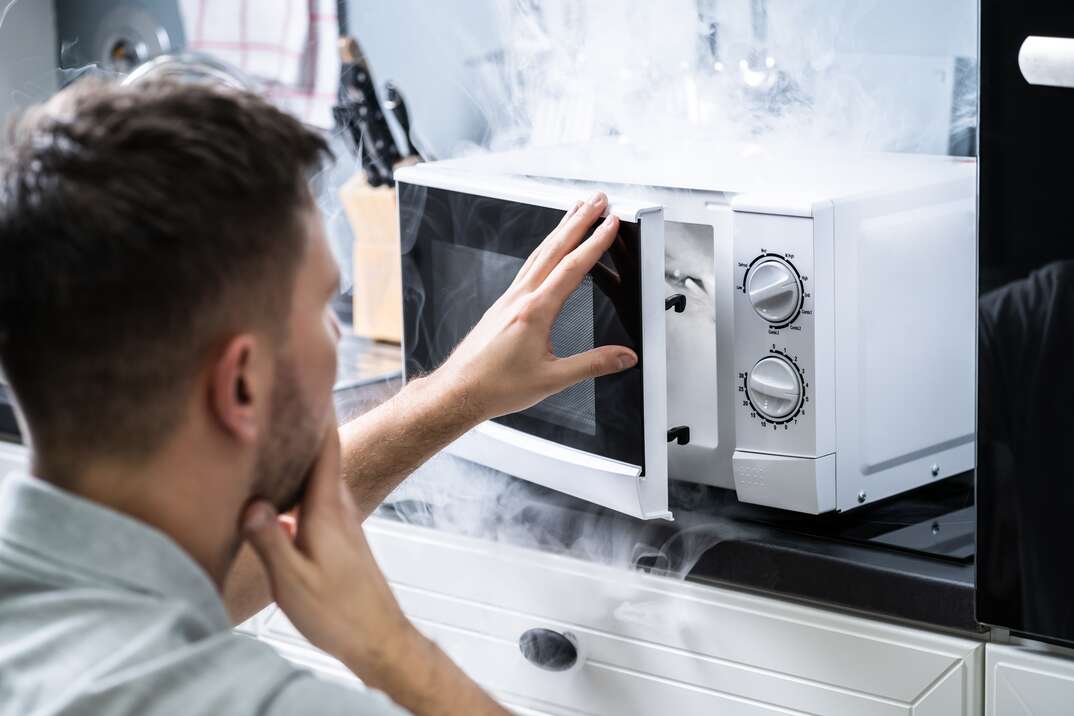- AppliancesElectriciansHVACLandscapingLocksmithPest ControlPlumbingRenovationRoofingT V RepairAll Home Improvement
- Car AccidentClass ActionCorporate LawCriminal DefenseDivorce LawEmployment LawFamily LawFinancial LawLegal AidMedical Injury LawyersMedical MalpracticeReal Estate LawWater Fire RestorationAll Legal
- InvestmentRetirementAll Finance
- Animal InsuranceAutoGeneral InsuranceHealth PolicyHome RentersAll Insurance
- DentalHealth SpecialistsAll Medical
- Animal CareVeterinaryAll Pets
- Auto GlassTowingAll Automotive
Why Is My Microwave Sparking and Arcing?

Microwave ovens are a vital part of any kitchen, not only because they’re so useful but because they’re so reliable. So when a microwave starts sparking and arcing, it’s unsettling. (It can also disrupt your reheating leftovers for dinner and popcorn movie nights.)
But before you throw the appliance to the curb, understanding the reasons behind the light show can help you determine the appropriate course of action.
Microwave ovens generate electromagnetic waves to heat food. When these waves meet anything metallic, they bounce around erratically instead of penetrating your dinner. This erratic bouncing can cause sparks or arcing (a mini-lightning bolt) within the microwave cavity. Here are the usual suspects:
Metal in the Microwave
While modern microwaves are designed to be safe for everyday use, placing metal objects inside can result in sparking and arcing. Metallic items such as aluminum foil, metal utensils and containers with metallic accents can reflect microwaves, causing electrical currents to flow and sparking to occur. Therefore, avoid putting any metal objects inside the microwave, as they can damage the appliance and pose a fire risk.
Food Particles
A common culprit behind microwave sparking is leftover food particles or grease within the appliance. When food debris accumulates on the interior surfaces, especially the walls or ceiling, it can lead to sparking during the cooking process. These particles can absorb microwave energy, become superheated and cause arcing.
Faulty Waveguide Cover
The waveguide cover is a small, rectangular-shaped piece located inside the microwave oven cavity. It protects the magnetron — an essential component that generates microwaves — from food splatters and moisture. If the waveguide cover becomes damaged or dislodged, it can expose the magnetron to food debris or grease, leading to sparking and arcing.
High-Voltage Capacitor or Diode Failure
While less frequent than the previous examples, internal components such as the high-voltage capacitor or diode can malfunction and cause sparking. These repairs are best left to qualified microwave repair technicians.
Is Microwave Sparking a Fire Risk?
A sporadic spark or two might not be an immediate fire hazard. However, if left unattended or ignored, it can potentially lead to more serious safety hazards. For instance, if food particles continue to accumulate and spark repeatedly, they could ignite and cause a fire. Additionally, if the sparking is due to a malfunctioning component, such as a faulty capacitor, it could result in electrical issues that increase the risk of fire.
More Related Articles:
- How Much Does Appliance Repair Cost?
- Should I Get the Extended Warranty When I’m Buying an Appliance?
- Scratch-and-Dent Appliances: What to Know Before You Buy
- Why Does My Dishwasher Smell?
- My Washing Machine Won’t Drain! Here are 3 Ways to Fix It
1. Unplug the microwave immediately: Think safety first. Don't open the door or attempt to use the sparking microwave. Disconnect it from the power outlet right away.
2. Identify the culprit: Check for any metal objects inside the microwave. Inspect the cavity for food debris, particularly around the waveguide cover.
3. Clean your microwave: If it's food debris, thoroughly clean the interior with a damp cloth and mild soap. Pay particular attention to the waveguide cover.
4. Evaluate the damage: If the culprit isn't metal or easily cleaned food residue and you suspect a deeper issue, it's time to call in a professional.
DIY or Call a Technician?
Here's when to consider a repair technician:
- If the sparking persists after cleaning
- If you suspect damage to the waveguide cover, such as visible signs of cracking and burning
- If you're unsure about the source of the sparking
Replacing a faulty waveguide cover might be a cost-effective solution if you feel confident enough in your DIY skills and you’re aware of the safety risks and what to do to keep yourself safe. However, diagnosing and repairing internal components, such as the capacitor or diode, is best left to trained professionals. Microwaves contain high-voltage capacitors that can hold a lethal electrical charge even after the appliance is unplugged. Disassembling a microwave for repairs can be dangerous and could also void your warranty. So if you have any doubts at all, call in an expert.
Finally, sparking is a warning sign, not a death sentence for your microwave. By addressing the cause promptly, you can likely get your appliance back in safe working order and enjoy those reheated dinners and popcorn again without any risks.
Elocal Editorial Content is for educational and entertainment purposes only. Editorial Content should not be used as a substitute for advice from a licensed professional in your state reviewing your issue. Systems, equipment, issues and circumstances vary. Follow the manufacturer's safety precautions. The opinions, beliefs and viewpoints expressed by the eLocal Editorial Team and other third-party content providers do not necessarily reflect the opinions, beliefs and viewpoints of eLocal or its affiliate companies. Use of the Blog is subject to the
Website Terms and Conditions.The eLocal Editorial Team operates independently of eLocal USA's marketing and sales decisions.



